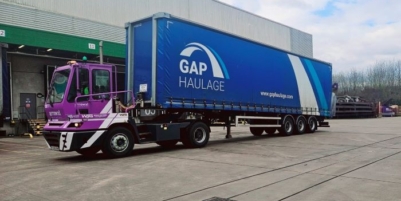-
Nutrivend selects Forterro’s Orderwise to support online expansion and streamline operations - April 11, 2025
-
ARROWXL LAUNCHES AMBITIOUS ZERO WASTE ROADMAP - April 8, 2025
-
THE BCMPA’S NEW CAMPAIGN DRIVES OUTSOURCING SUCCESS IN Q1 - April 7, 2025
-
BLACKOUT TECHNOLOGIES TARGETS TELEMATICS-INTEGRATED MOBILE DEVICE BLOCKING TO COMBAT SMARTPHONE DISTRACTION - April 1, 2025
-
Sparck Technologies awarded Royal designation - March 27, 2025
-
OpenADR Alliance announces first OpenADR 3.0 certified products with EVoke Systems, E.ON Energy and Universal Devices - March 25, 2025
-
Growing fulfilment and contract packer appoints new Managing Director - March 25, 2025
-
When is it time to invest in a WMS? Understanding the key trigger points - March 25, 2025
-
eCapital helps Vantage Recruitment on its journey to financial success - March 24, 2025
-
Hugo Beck Celebrates 70 Years of Packaging Innovation with Open House Events - March 20, 2025
The skills shortage within the supply chain and logistics sector is a recognised problem. When Brexit brought the end to freedom of movement between the UK and Europe, a huge number of logistics workers were lost from British firms. Between March 2020 and October 2021, the number of European nationals filling driving jobs in the UK fell by more the 15,000 but that’s not the only problem. Research by the International Road Transport Union reports a 40% shortfall in truck drivers globally. While 86% of British companies have experienced warehouse operative staff shortages in the past two years, leaving the logistics and supply chain industry struggling.
Finding solutions to reduce employee attrition in the sector has become a significant priority and frontline workforce technology could provide the answer.
How frontline workforce technology could help in the logistics sector?
The intended role of frontline workforce technology was to create cohesion within a business. With digital tools, such as open-shift management and two-way communication platforms, businesses could enhance employee engagement and ensure that information always got to where it needed to be. When implemented across an organisation it also improves the employee experience, helping employees to feel more valued and improving loyalty through an increased sense of trust and autonomy. All of these can lead to a reduction in employee churn, bringing productivity and cost value to a business.
How can technology change the employee experience in logistics?
Frontline workforce technology comes in a range of guises but its primary functions are to enhance communication and instil a sense of autonomy. It can do this in a number of ways.
Scheduling flexibility
Regardless of the industry you work in, scheduling is usually one of the biggest causes of contention for frontline workers. Last-minute shift changes, an unpredictable schedule where days off float around the needs of the business rather than remaining static or a shift pattern that clashes with personal responsibilities. These can all cause headaches for individual workers and when concerns aren’t addressed, it can quickly lead to discontent.
With the use of open-shift management platforms, employees are empowered to manage their own schedules. With a simple shift-swapping capability, workers can switch shifts between themselves without involving management. They can take on additional shifts when they could use the extra cash, or when the business is struggling – potentially in different departments, on different sites, or even with sister brands, if it is appropriate to do so.
A sense of purpose and a sense of trust
When you work in a large organisation, it’s easy to feel like a tiny, unvalued cog. The way that you manage employee communication can change that. To enhance employee engagement and build a stronger sense of value and trust, you need to be able to connect with your team members. Staffroom memos and rushed team briefings aren’t the way to do that. Two-way communications technology helps to ensure that every piece of information gets to all relevant employees when they are ready to deal with it, allowing for consistent messaging throughout the business. It also provides employees with the power to ask questions. If they don’t understand a communication or – importantly – if they disagree with it, they have the power to share their views, ask for support, and provide an opinion. Not just to their direct line managers – although this would usually be the first point of contact – but to anyone else within the business, across levels. Quickly, efficiently, and without jumping through hoops, while MDs striving to live up to an ‘open door policy’ can actually be true to their word.
This helps to build trust within the rank and file. While helping each individual worker to better understand their role within the business. And increasing their sense of value and purpose.
Personal development
Another area that strongly influences employee’s sense of value is career development. Last year, McKinsey & Company found that more than 70% of frontline workers have applied for career advancement opportunities – either within the business they currently work for or with other employers. Integrating technology that facilitates ongoing development within a communications platform can benefit the business through seamless, self-managed upskilling and the individual by enabling them to easily pursue their own career path – with the support of the business and a tailored training programme.
Attrition in logistics is influenced by a whole variety of factors. Pay, working conditions, and benefits all factor. But a sense of value is a powerful thing and happiness at work is often more important than a pay rise. If you can help your team members to feel valued and in control, you are more likely to win their loyalty.
Mark Williams, Managing Director EMEA at WorkJam. WorkJam was founded in 2014 to improve the lives of frontline workers. As the world’s leading digital frontline workplace, WorkJam combines communication, task management, scheduling tools, learning, and more – all on one app. It is the only complete and unified system designed to revolutionise the way HQs and their frontline work together, boosting efficiencies and productivity.
































